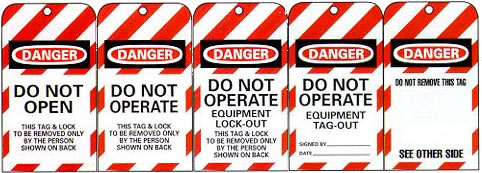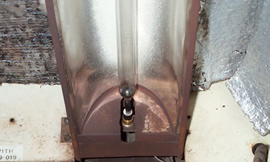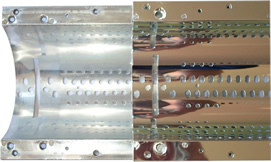Guide to UV Measurement
Maintenance of UV Systems
Maintaining a UV system involves:
- Keeping the system not only operating but running as designed and as needed for your process
- Quickly identifying changes and either fixing or compensating for the changes in the equipment
- Predicting when preventative maintenance needs to be done
The time interval between checks, maintenance and preventative action will depend on your equipment, UV system, process and operating environment.
Work with your UV equipment manufacturer to establish a list of replacement parts to stock to handle the normal wear, tear and aging or the system. Become familiar with the system before it breaks or production stops. Have replacement lamps in stock.
Be sure to follow safety precautions to prevent accidents. Allow equipment to cool before handing. Lockout or tag-out the equipment/electrical supply when you are performing maintenance or repairing equipment.

The following items are some of the things that should be checked and maintained on a regular scheduled basis.
-
Reflectors The reflector is the workhorse in most UV systems. Somewhere between 60-80% of the energy that reaches the substrate is reflected energy. In order to maximize the amount of UV reaching the cure surface, the reflector has to be properly maintained. The information that you record and track on your system will give you clues as to when the reflector(s) needs to be cleaned. Follow the recommendations of the UV system manufacturer to clean the reflectors.
|
 Dirty Reflector |
Stay away from anything that will damage the reflector’s surface. Measure the system with your radiometer, clean the reflectors, rotate the UV bulb if possible, reassemble the system and take another measurement, looking for improvement. The position and diameter of the bulb in the reflector, the shape and material of the reflector, distance to the substrate, pattern of light on the substrate (focused, non focused) and cooling mechanisms (air flow, water cooled, heat sinks) are all carefully evaluated when designing a system. It is important to maintain the systems as designed.
There is a tendency on some very wide UV systems for the middle of the UV lamp to sag slightly over time. This slight sag can alter the design and reflective geometries in the system. Less UV is delivered to the substrate when the UV lamp sags. The potential for lamps to sag is the reason to rotate the UV lamp when cleaning the reflector. On wide systems, it is important to measure in several places across the width of the conveyor. It is also important to measure and document if the UV drops off near the edge of the conveyor.
-
Material Handling Systems How is your substrate moved or placed under the UV source? This may involve checking a conveyor belt, web, shutter, timer or other transport/timing mechanism. If the exposure time is not consistent, the amount of UV reaching the cure surface will not be consistent.
-
Power Supply The power supply is not something that you normally monitor or think of on a day-to-day basis for process control. Follow the manufacturer’s directions for maintenance, installation and power feed requirements. Be aware that there are several types of power supplies available and they are not always interchangeable. Some power supplies may limit the types of bulbs that you can use in your system. Work with your suppliers to determine the best power supply for your UV equipment and application if you are looking at new equipment or replacing an existing power supply
-
System Cooling/Exhaust Air and/or water are commonly used to cool the UV system. Work to ensure that the cooling on your UV system continues to operate as it was designed. Watch for changes or blockages in the flow of air and/or water into or out of the system. Communicate with the manufacturer of the equipment when contemplating changes or additions in your equipment or to the cooling/exhaust systems in your facility. If you live in an area that experiences vastly different conditions between winter and summer, work with the manufacturer to determine if you need to make changes. Set up a schedule to check and inspect exhaust vents. If your lamp system uses ‘positive’ (pressure) cooling, make sure air filters are in place and are replaced regularly − this insures that your supply air is maintained and reduces the need to clean bulbs and reflectors so often.
-
Hour Meter The hour meter can assist you in establishing preventative maintenance schedules. It can tell you the number of hours on a current bulb, but the hour meter can not tell you the amount of UV being produced and reaching the cure surface or the operating conditions on other pieces of equipment in the system.
Spectral Output The spectral output of your UV system must be matched to your process and chemistry. There are many types of lamps available. The type of lamps that you use will depend on your formulation, type of process and desired results. It is normal to expect small variations in the lamp over time as it ages.
Each system manufacturer can tell you what types of lamps your system can use. Lamps are not always interchangeable and some older UV systems may not have a power supply ‘kicker’ to ignite additive (mercury-gallium, mercury-iron) lamps. Buy your UV lamps on value (stability, consistency, effective useful UV output over time) instead of the lowest dollar cost per unit.
Unique variables Determine if your equipment or process has any unique variables, which need additional monitoring and maintenance. An example would be the monitoring of oxygen levels for nitrogen i nerted systems.
Develop a preventative maintenance plan and log for each of your UV systems.
If there are problems:
- Confirm key equipment settings and measure UV levels to double check or confirm current readings.
- Perform UV system maintenance: Observe all safety precautions, follow manufacturer’s instructions and company procedures to check and clean the reflectors, rotate the bulbs, check cooling and air flow on the housing
- Measure the UV again, looking for improvement and movement back within the process window
- Replace UV bulbs or adjust key equipment variables until you are back in your process window
- Work and communicate with all suppliers in good times and bad times
